Last updated: June 9, 2023
Article
The Old Mormon Fort: Birthplace of Las Vegas, Nevada (Teaching with Historic Places)
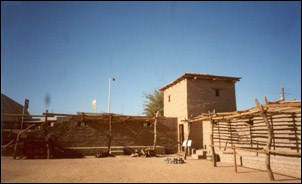
The company paraded at the dawn of day and fired a salute very spiritedly; also at sun-up and again when the liberty pole was erected and the flag floated majestically to the breeze, another salute was fired the company having previously assembled, kneeling down and offering up their devotions to God. Afterwards there were many spirited speeches, songs, and toasts from many of the brethren. Then all were dismissed by prayer and went to perform our several camps duties.¹
John Steele, one of the first of the Mormon Missionaries to arrive at what became the "Las Vegas Mission," wrote the above in his journal to recount the activities of the first Independence Day celebrations in 1855. The group arrived from Salt Lake less than three weeks before on June 14, after being called by President Brigham Young to establish this mission to convert the nomadic Southern Paiute Indians to Mormonism and teach them new farming techniques. On the Old Spanish Trail between New Mexico and California, the Las Vegas Valley was an oasis in the desert. The Mormons wanted to establish a halfway station in the valley for travelers between Salt Lake City and the Pacific Coast. The area was particularly coveted for Mormon territorial expansion because it was located halfway between the Mormon settlements of Southern Utah and the San Bernardino Mission established in 1851 in Southern California.
After the mission closed, the Old Las Vegas Mormon Fort served as a ranch, resort, and cement testing facility. Today, a small portion of the original fort wall, part of the bastion, the underground foundation of the ranch, and remnants of the testing lab, remain to tell the story of the origins of Las Vegas.
On June 11, 2005 the Old Las Vegas Mormon Fort came alive again as re-enactors (many descendants of the original Utah Pioneers) brought Old Glory out at the fort yard as they had done 150 years before. Ranch owner, Helen Stewart, was seen on the grounds. Civil War re-enactors recalled the war's importance to Nevada's history. Lunch was served by the pioneers in Dutch ovens like they used in the past. All of this was done to honor the memory of the many faces that contributed to the history of the Old Las Vegas Mormon Fort, and promote its legacy in hopes of preserving it for future generations.
¹ Excerpted from John Steele's diary reprinted in The Fortress, Vol. 1, No. 4 (Las Vegas, Nevada: Friends of the Fort, 2000); also cited in Our Pioneer Heritage.
About This Lesson
This lesson is based on the National Register of Historic Places nomination for Las Vegas Mormon Fort (with photographs), materials from Nevada State Parks, and other sources in Nevada and Utah related to the fort and the expansion of the Mormons. The lesson was written by Dr. Linda Miller, a retired secondary social studies teacher and adjunct at the Community College of Southern Nevada. The lesson was edited by the staff at the Teaching with Historic Places program and historians in Las Vegas. This lesson is one in a series that brings the important stories of historic places into classrooms across the country.
This lesson was produced in 2005, the 100th anniversary of the founding of Las Vegas and the 150th anniversary of the building of the Old Las Vegas Mormon Fort.
Where it fits into the curriculum
Topics: This lesson could be used in American history and social studies units on Manifest Destiny and the expansion of the West, especially as a case study on Mormon expansion, and women's history. This lesson could also be used in units on relations between American Indians and European Americans.
Time period: Mid 19th century to early 20th century
United States History Standards for Grades 5-12
The Old Mormon Fort: Birthplace of Las Vegas, Nevada
relates to the following National Standards for History:
Era 4: Expansion and Reform (1801-1861)
-
Standard 1C- The student understands the ideology of Manifest Destiny, the nation's expansion to the Northwest, and the Mexican-American War.
-
Standard 2E- The student understands the settlement of the West.
-
Standard 4C- The student understands changing gender roles and the ideas and activites of women reformers.Era 6: The Development of the Industrial United States
(1870-1900) -
Standard 1B- The student understands the rapid growth of cities and how urban life changed.
-
Standard 1C- The student understands how agriculture, mining, and ranching were transformed.
-
Standard 4B- The student understands the roots and development of American expansionism and the causes and outcomes of the Spanish-American war.
Curriculum Standards for Social Studies
National Council for the Social Studies
The Old Mormon Fort: Birthplace of Las Vegas, Nevada
relates to the following Social Studies Standards:
Theme II: Time, Continuity and Change
-
Standard B - The student identifies and uses key concepts such as chronology, causality, change, conflict, and complexity to explain, analyze, and show connections among patterns of historical change and continuity.
-
Standard D - The student identifies and uses processes important to reconstructing and reinterpreting the past, such as using a variety of sources, providing, validating, and weighing evidence for claims, checking credibility of sources, and searching for causality.
Theme III: People, Places and Environments
-
Standard D - The student estimates distance, calculates scale, and distinguishes other geographic relationships such as population density and spacial distribution patterns.
-
Standard F - The student describes physical system changes such as seasons, climate and weather, and the water cycle and identifies geographic patterns associated with them.
-
Standard H - The student examines, interprets, and analyzes physical and cultural patterns and their interactions, such as land uses, settlement patterns, cultural transmission of customs and ideas, and ecosystem changes.
-
Standard I - The student describes ways that historical events have been influenced by, and have influenced physical and human geographic factors in local, regional, national, and global settings.
Objectives for students
1) To describe why the Mormons came to Las Vegas, what they hoped to accomplish, and what experiences they shared in establishing an outpost.
2) To list at least four factors--including the arrival of the Mormons--that influenced the stability and growth of the initial Las Vegas settlement into a permanent community and explain the importance of each to westward expansion.
3) To describe the experience of Helen Stewart, one of the first non-native women inhabiting the Las Vegas Valley, and outline her contributions to the area.
4) To research and report on the history of local historic places that help tell the story of their own community's origins and development.
Materials for students
The materials listed below either can be used directly on the computer or can be printed out, photocopied, and distributed to students. The maps and images appear twice: in a smaller, low-resolution version with associated questions and alone in a larger version.
1) Three maps showing the western part of the U.S. and the location of the Old Las Vegas Mormon Fort;
2) Three readings tracing the development of Las Vegas beginning with the Old Las Vegas Mormon Fort;
3) Two excerpt from a missionary's letter and Helen Stewart's letters;
4) Four photographs showing how the fort changed over time and Helen Stewart;
5) one historical drawing of the area;
6) one historical paainting of the fort.
Visiting the site
The Old Las Vegas Mormon Fort is administered by Nevada State Parks. It is located in Las Vegas, Nevada, north of the downtown area at the corner of Washington and Las Vegas Boulevard. The park's entrance is on Washington Street at 500 East Washington, next to the Natural History Museum on Las Vegas Boulevard. The park is open daily from 8 a.m. to 4:30 p.m. There is an admission price to enter the park. Guided tours are available upon request. For more information write to Old Las Vegas Mormon Fort State Park, 500 East Washington Avenue, Las Vegas, Nevada 89101, or call 702-486-3511, or visit the park's website.
Getting Started
Inquiry Question
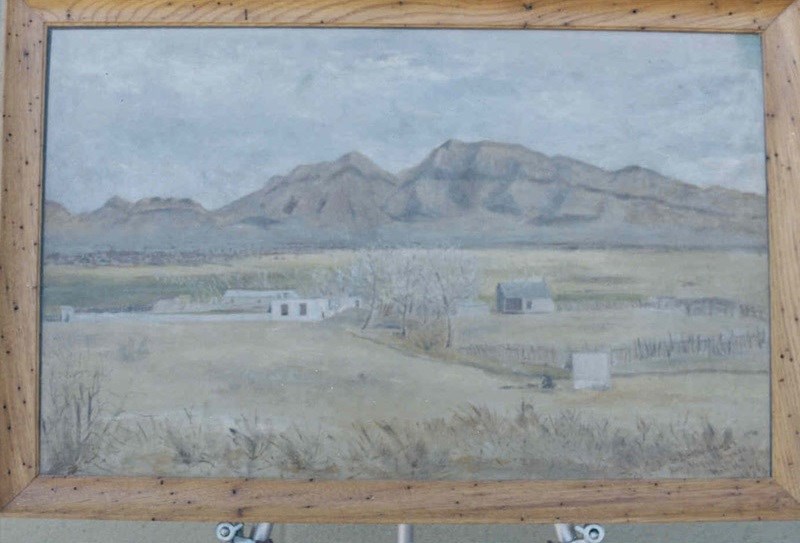
What do you think the painting is depicting?
In what part of the country do you think these structures might be located?
Setting the Stage
During the Spanish Colonial Period (1542-1821) in the American Southwest, the Spanish empire was competing for control over resources with the British, French, and Russian monarchies. They attempted to link colonies in the Spanish territories, later known as the New Mexico and California, by establishing trade routes to form a passageway across the entire Southwest desert region. The Old Spanish Trail was used commercially to link the towns that would later become Los Angeles, California, and Santa Fe, New Mexico, from 1829 until 1848. The abundant spring water available in the Las Vegas (meaning "the meadows" in Spanish) Valley made it an ideal resting point on the trail.
The presence of the valley springs also drew the Southern Paiute Indians, a nomadic people moving frequently during the year, who made the valley their winter homeland. They raised small crops near the springs in the valley, which provided water and food for the Indians inhabiting the area and later for travelers making their way across the desert.
The Las Vegas Valley would become an attractive place for other European-American settlers as well. One group of settlers looking for a new home was the Mormons--also known as the Church of Jesus Christ of Latter-day Saints--a religious sect organized by Joseph Smith in New York in 1830. Based on the Book of Mormon, which Smith said was revealed to him by heavenly messengers, this religious body felt called to restore the authentic church established by Jesus and his Apostles. The history of the Mormons is dramatic--filled with persecution, an exodus from the eastern part of the United States, and ultimately successful establishment of a thriving religious society in a desert. The Mormons formed in upstate New York, an area where the Second Great Awakening was most popular as the United States underwent a widespread flowering of religious sentiment and unprecedented expansion of church membership. The group was forced to move several times because of conflicts with residents in various places where they settled, including Ohio, Missouri, and Illinois. They were accused of blasphemy and inciting slave insurrections. After Smith was killed by an angry mob in Illinois in 1844, it became necessary for the Mormons to find a new home once again.
A new leader emerged to guide the Mormons to a new Zion at the Great Salt Lake. Under the direction of Brigham Young, they began an arduous journey West to what would become Utah, where they arrived in July of 1847. In 1848, after the war with Mexico, the United States acquired the majority of what now constitutes the American Southwest. The Mormons petitioned Congress to become the State of Deseret, a word from the Book of Mormon signifying honeybee which was considered an industrious creature, but they were only allowed territorial status. Congress established the Territory of Utah, named for a local Indian tribe, and President Fillmore appointed Brigham Young governor in 1851. Young also became superintendent of Indian affairs. He oversaw the building of Salt Lake City and hundreds of other southwestern communities.
In the middle of the 19th century, the idea of "Manifest Destiny"--a phrase used to explain continental expansion by the U.S.--was embraced by many American people, including the Mormons. They began an industrious campaign to colonize Utah and beyond, establishing hundreds of settlements throughout the West and Southwest. As part of this process, Brigham Young called on volunteers to create a Las Vegas Mission, which would be strategically located alongside the Mormon Road (a portion of the Old Spanish Trail between New Mexico and California), halfway between the Mormon settlements of southern Utah and the San Bernardino Mission in southern California. There were eventually 96 settlements that included Lehi, Provo, Payson, Nephi, Fillmore, Beaver, Parowan and Cedar City. Meanwhile, the discovery of gold in California in 1848 made southern Nevada a corridor for westward emigrants and gold seekers. A gold seeker wrote in his diary on November 21, 1849 about stopping at the Las Vegas creek.
Offering the only reliable supply of water for a 55-mile stretch along the Mormon Road, the Las Vegas Valley's springs were important for watering the mules, horses and oxen of travelers crossing the region's harsh desert environment. With the opening of the San Bernardino settlement in 1851, there was an additional need for a way station at the Las Vegas springs to provide supplies and rest. The mission the Mormons established as part of the Church's westward expansion out of Utah became the first non-native settlement in the area, and the Mormons hoped to bring the American Indians into their flock. Although the Mormons occupied the site only from 1855 to 1858, it affected the development of what was to become southern Nevada.
Locating the Site
Map 1: Forty-Niners Map.
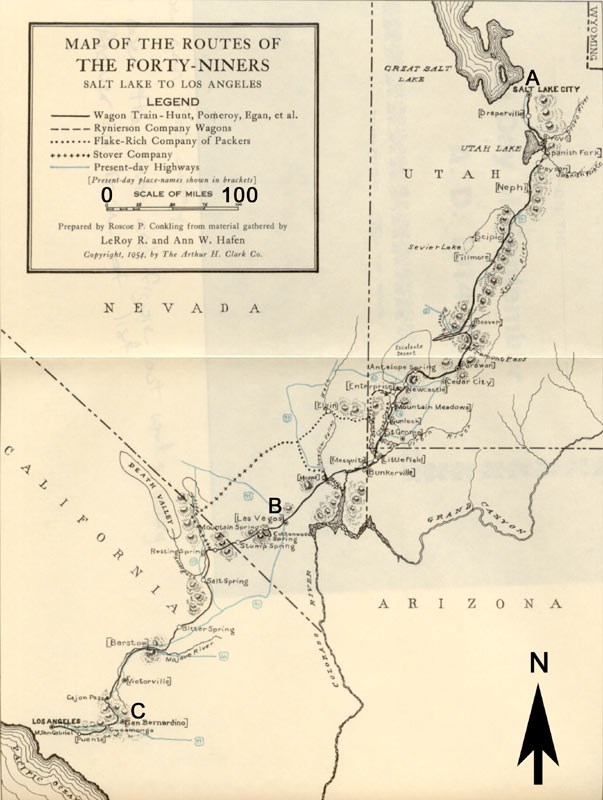
(Journal of the Forty-Niners, Arthur H. Clark Company, 1954. Used with Permission.)
Key:
A) Salt Lake City
B) Las Vegas
C) San Bernardino
Forty-Niners is a term used to describe the gold-seekers who migrated to California after the 1848 gold discovery at Sutter's Mill. Map 1 shows routes used by gold-seekers from Salt Lake to Los Angeles.
Questions for Map 1
1. Using the scale, measure the distance between Salt Lake and Las Vegas, and then Las Vegas and San Berndardino. What kinds of terrain did missionaries traveling this route have to cross? What methods of transportation do you think might have been available along this route in the 1850s?
2. Does this map give you a better idea how difficult it was for the pioneer Mormons to settle the Las Vegas area? Why or why not?
3. How did the discovery of gold help promote a need for a way station? If needed, please refer to Setting the Stage.
Locating the Site
Map 2: John Steele's map, 1855.
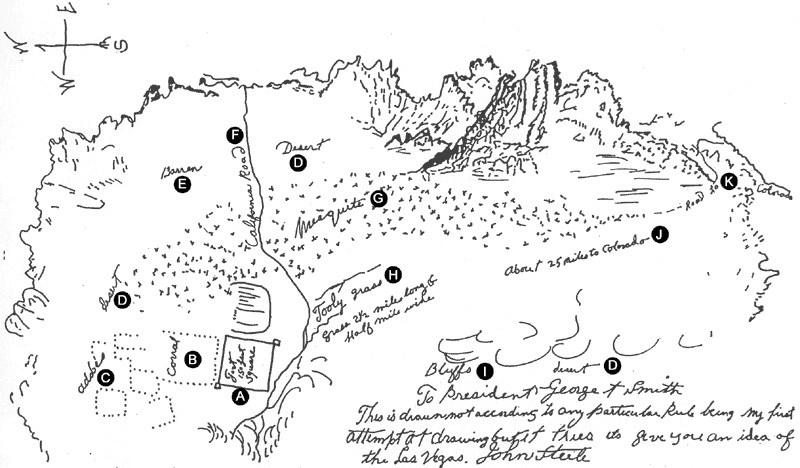
Key:
A) Fort 150 feet square
B) Corral
C) Adobes
D) Desert
E) Barren
F) California Road
G) Mesquite
H) Tooly grass--grass 2 1/2 miles long & half mile wide
I) Bluffs
J) About 25 miles to Colorado
K) Road to Colorado
This is a copy of John Steele's map of the Las Vegas mission. He was one of the Mormon missionaries sent by Brigham Young.
Questions for Map 2
1. Describe the buildings in the drawing. What purpose might they serve?
2. What geographic features did Steele include on his map, which ones might make this a good place to build a fort?
Locating the Site
Map 3: Las Vegas, Nevada
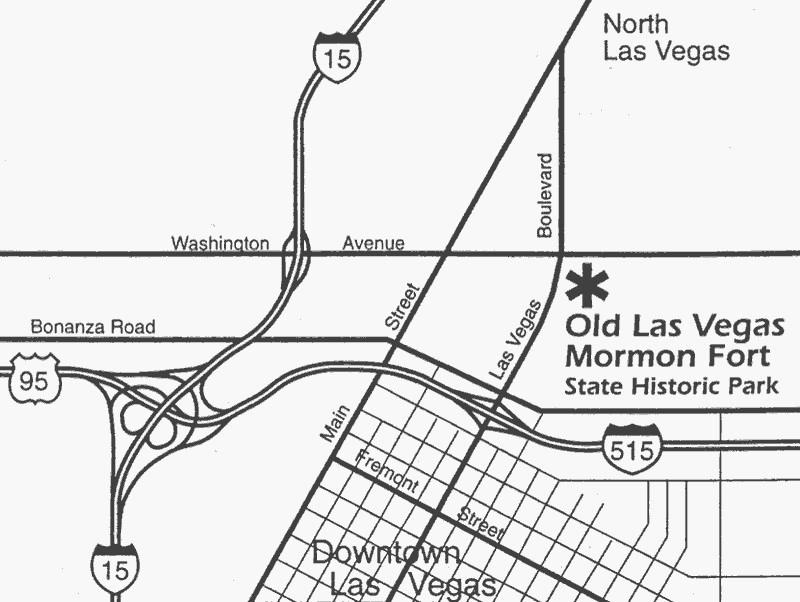
Questions for Map 3
1. Locate the Mormon fort today. What is the proximity of the fort to downtown and the highways?
2. Comparing Maps 1, 2, and 3, as well as using what you know, or have heard about Las Vegas, NV, how would you say this area has changed over time?
Determining the Facts
Reading 1: The Mormon Years
Army officer and explorer, John C. Fremont visited the Las Vegas Valley on May 3, 1844. After he publicized it in his "Report of the Exploring Expedition to the Rocky Mountains 1842 to Oregon and Northern California in 1843-44," the valley became better-known by European-American travelers. During his journey along the Old Spanish Trail, he collected geographical information, military intelligence, and made scientific observations of the environment and topography. He noted the excellent quality of the Las Vegas Valley springs. His report greatly enhanced the American public's understanding of the West, and helped establish the route of the upcoming Mormon Road for wagon freight traffic and emigration between Salt Lake and Los Angeles. During the years 1848-50 the majority of the traffic on the Old Spanish Trail related to the Gold Rush in California. As early as 1850, Mormon leaders were considering San Bernardino, California as a possible mission location. The main route between Salt Lake City and the Pacific Ocean became known as the "Mormon Corridor." The "Mormon Corridor" part of the Spanish Trail was the only road that remained open in winter, and the Mormons and their settlements were instrumental in its protection and development.
The history of the Las Vegas Mormon Fort began in 1855 when Brigham Young, the leader of the Church of Jesus Christ of Latter-day Saints at Salt Lake City selected 30 men to establish a mission in the Las Vegas Valley. They left on April 10 and were told to go prepared to survive on what they could raise and fare as best as they could. The mission was the first settlement in the part of the New Mexico Territory which would later become the southern end of the state of Nevada. The Mormons' purpose here was to raise crops which would not grow in the colder Utah climate, convert the local Indians to Mormonism and instruct them in farming and hygiene, build a fort and settlement, establish a halfway station for protecting travelers on the Mormon Road between the Pacific and Salt Lake City (to establish a base for trade along the trail), set up a post office, and explore the country. Each man was given 2 ½ acres of land plus ¼ acre for a garden.
The journey took the men 30 days, with the last 55 miles through a waterless desert. William Bringhurst, president of the mission, arrived with most of the group at Las Vegas on June 14, 1855. The mission was temporarily named for Bringhurst because there was already a Las Vegas in the New Mexico Territory. The site chosen for the mission was four miles from the Las Vegas Springs and next to the Las Vegas Creek where the creek dropped over a bluff about 12 feet high. This drop provided the force to power a mill built by the settlers. The Las Vegas Mission consisted of an adobe wall enclosure measuring 150 feet square. Work soon began on the fort with fortifications on the southeast and northwest angles. A corral measuring 150 feet long and 132 feet wide was built on the north side of the fort according to the diary of one of the missionaries, John Steele. The walls were two feet thick through the bottom eight feet and one foot thick at the top. Later photographs show gun ports in the walls. Inside the fort, the mess houses provided defense for the east side. The men cleared the mesquite brush from the land below the fort, dug ditches, and laid out farmland. They labored in heavy woolen garments on days that sometimes reached 110 degrees; so the hot weather and winds made farming difficult and prevented a long work day.
They planted a variety of crops such as corn, melons, and oats. Peas and beans were less successful. When the first winter came, a severe frost ruined the crops.
President Bringhurst often engaged in fiery preaching to improve the morale and performance of the men. Discontent grew not only over Bringhurst's harsh leadership as he punished the men for minor offenses, but also from the men's desires to be with their own families and continued misunderstandings between the Mormons and the Paiutes regarding individual and group property rights. Eleven missionaries secured permission to return to Utah on November 8, 1855. Others, also, would make trips back and forth from Las Vegas to Salt Lake at various times.
Post Office services were offered in January 1856 when the legal address of the "Bringhurst Post Office, Las Vegas County, New Mexico," was opened at the fort. The station was named for William Bringhurst, President of the Las Vegas Mission. Mail was a constant topic discussed in the letters between the missionaries and their families in Salt Lake. They received monthly deliveries.
A second call from Salt Lake City took place for additional missionaries to come to Las Vegas in February 24, 1856. This time, the men were allowed to bring their families. Thus 23 men and 14 women and 15 children came to the fort. Brigham Young sent a new directive to the fort, instructing missionaries to grow cotton, mine for lead, and to further advance the cause of religion. Because the families had to set up house, regulate the children and provide for family needs, the Mormon community built a school and selected two teachers. In August the first child--Zilpha Fuller, daughter of Elijah Fuller's third wife Ellen Fuller--was born at the fort. Ellen gave birth to her daughter in a wagon box. Life for the families was grueling as they endured dehydration and extreme temperatures.
After the discovery of lead by an American Indian on April 19, 1856, Brigham Young sent Nathaniel Jones to open a mine approximately 35 miles southwest of the fort at Potosi Mountain in the Spring Mountains. Some settlers remained at the fort while others tried mining. Young felt that the lead mining was important to make bullets for hunting and protection from a possible invasion. Unfortunately, the ore was of poor quality and the venture proved unprofitable. On May 22 Jones and his mining crew left for Utah, returning to Las Vegas in August. Jones and Bringhurst quarreled bitterly regarding authority over the mining mission. A second letter arrived from President Brigham Young on August 19 reconfirming Jones' authority over the mining mission and obliging Bringhurst to aid him in any way that he could. Dissension continued to grow over the leadership styles of Bringhurst, who was harsher, and Jones, who was more liberal.
After another trip to Utah, Jones returned in December with a letter from Young upholding him and releasing Bringhurst, who left the mission. The conflict demoralized the settlers, who desired to return to Utah. They were discouraged because of the uncertainty about whether they were going to have to stay or be allowed to go home, and also because of the uneasy feelings between them and the American Indians. On February 23, 1857, the missionaries received a letter from President Young informing them that they were free to close down the mission and return to Salt Lake. Dissension, lack of supplies, uncertainty about the mission leadership, social problems, and lack of good crop lands all contributed to the failure of the mission. On March 23 the exodus began, and by mid 1857 the mission was nearly deserted.
During this time the relationship between the federal government and the Mormons deteriorated. President James Buchanan threatened to send federal troops to Salt Lake. In mid 1857 due to the advance of the United States Army into Eastern Utah, Brigham Young called his followers from all points to defend the City of Saints against the Gentiles. In July President Buchanan removed Brigham Young as territorial governor and appointed a new non-Mormon governor, Alfred Cumming. The Mormons prepared for war and then allowed federal forces to enter the Mormon capital peacefully after negotiations involving the army and the church. In April 1858 the Utah War ended.
In 1858, Amasa Lyman led a small party from Salt Lake back to the fort to work at the mines. The mission continued until September 26, 1858 when a meeting was held and the decision was made to disband and return home. The fort was left to deteriorate. However short and rocky the mission's life was, it later helped pave the way for the settlement of southern Nevada. On March 2, 1861, President Buchanan signed An Act to Organize the Territory of Nevada. Nevada became the 36th state on October 31, 1864, thanks to the arrival of population due to the discovery of gold and silver in the Virginia City area, and because Republicans led by Abraham Lincoln wanted the state's support in elections and in Congress.
Questions for Reading 1
1. How did John C. Fremont's expedition spur settlement in the area?
2. What were the motives behind the Mormon expansion from Utah to Las Vegas? Why did the Mormons select this particular site?
3. How was the fort built? What was the original layout of the fort? If need, please refer to Map 2. What was life like for those who lived there?
4. What was the mission of the Mormon settlers at Las Vegas? Did they succeed? Why or why not? Why did they dissolve the fort and return to Salt Lake City?
Reading 1 was compiled from Archeological Reconnaissance of the Las Vegas Mormon Fort (Las Vegas, Nevada: WESTEC Services, 1981); Michael Bowers, The Sagebrush State: Nevada's History, Government and Politics (Reno: University of Nevada Press, 1996); Karen B. Carter, Our Pioneer Heritage (Salt Lake City, Utah: Daughters of the Utah Pioneers, 1970); Robert Elston and Alvin McClain, Old Las Vegas Mormon Fort: Historical and Archeological Perspectives (Silver City, Nevada: Intermountain Research, 1993); James Hinds, One Hundred and Twenty-five Years at Las Vegas' Old Fort: A Historic Structures Report of Las Vegas Fort and Ranch (Las Vegas, Nevada, n.d.); Dean Heller, Political History of Nevada, 1996 (Carson City: State of Nevada, 1997); Las Vegas Fort: Old Values, New Meaning (Clark County, Nevada: Preservation Association of Clark Co., October 1980); Martha Knack, Boundaries Between: The Southern Paiutes, 1775-1995 (Lincoln, Nebraska: University of Nebraska Press, 2001); Old Las Vegas Mormon Fort Museum exhibits; Stanley Paher, Las Vegas as It Began--As it Grew (Las Vegas, Nevada: Nevada Publications, 1971); Fred E. Woods, A Gamble in the Desert: The Mission in Las Vegas (1855-57) (Salt Lake City, Utah: Mormon Historic Sites Foundation, 2005).
Determining the Facts
Document 1: John Steele's Letter
The Missionaries kept diaries and sent letters home. They took part of their days to write to their families. Following is an excerpt from John Steele describing conditions at the fort. The underlined blanks indicate words that were indecipherable in the letter and the question marks indicate uncertainty of the word by the transcriber.
Las Vegas October 13/1855 ____ New Mexico
My Dear Catherine
I sit down this morning to address these few lines to you hoping your health is better than when you last wrote and also hoping thet the children also have got rid of their cold and enjoy good health. I have felt rather poorly for awhile past. I got cold working in the adobe yard and rheumatism took ___ in my shoulder and laid me up for two or three days so that I could do nothing but still it did not slacken my labors much and wanted to get my portion of the fort up and also my stuff ___ ___ and wound up that if possible I may have a chance to come home this winter Steven Perry, William G. Mitchell Jr., Sidney Carter and myself is in a mess together? building our portion of the Fort amounting to 33 feet of wall 2 feet thick and 14 feet high and we are getting along pretty well with it It is up 8 feet now and we still lack over two thousand adobies and for that I must get into the mud? again I was working the last two days making? and I think 4 more days more will finish and then we will have to build the rest of the wall which I think will take the most of two weeks and by that time Captain Bringhurst will be back from California and if possible I will come home starting in about three weeks if I can get the chance which I think is possible & that will bring me there about the 17 (sometime) of November therefore you need not send the papers of ___ November mail Steven Perry and Benjamin Cliff? is coming this mail but the can tell you nothing about whether I will be there or not so you need not bother your head I do not think I will say much at this time as I shall probably have a chance to come home and cary my ___ letter myself I expect the mail in today & this is Saturday (always a buisy day) you would like to know how I get along with my washing ___ I will tell you about it when I come home I have just to wash a shirt to preach in tomorrow as every stick is dirty now but still I get along first rate and wash make and mend like some? old woman taking all things into consideration I get along very well You say you are ___ without ___ as yet I believe that and also hope that you will continue so I never go to sleep but what the welfare of you & thy children are last in my mind and I pray continually to the Lord for you & them that he will watch over you and keep you from going astray I wrote to Brother & sister ___ and sent the letter by Myran Tanner? I also wrote to Sister Wilkins I am very glad you got the Tea but he had to go on without his pay because I had not corn? to pay him But I expect to ___ things so that he can have his pay when he comes back whether I am here or not. I had a letter the last mail from George A. Smith he has been sick but I supose he is now better. Kiss the children for me now & when I come I will do it also I will bring the grapes for ___ May the Lord bless you with every good thing.
Yours as ever John Steele
John Steele Papers, Vault MSS 528, Box 1, Folder 12, L.
Tom Perry Special Collections
Harold B. Lee Library
Brigham Young University
Provo, Utah
Questions for Document 1
1. How long had the Mormons been in the Las Vegas Valley when this was written? If needed, refer to Reading 1. What hardships and setbacks did they face?
2. How well did the missionaries seem to be working together? What is the evidence for your answer?
3. How useful do you think the missionary journals and letters would have been to the Mormon leadership in Salt Lake City? How important are they in helping historians understand the past today?
4. Concern for family was one reason why the Mormons left the mission. How is that reflected in this letter?
Determining the Facts
Reading 2: The Ranching Years
The first ranching activity in Las Vegas began in the fall of 1865 when Octavius Gass, a miner, settled on the site of the abandoned Mormon mission and began development of the Las Vegas Ranch. The property was situated in Arizona Territory until 1867 when Congress transferred the area to Lincoln County, Nevada. Gass called his ranch Los Vegas Rancho--deliberately changing the spelling so as not to be confused with Las Vegas, New Mexico, another settlement about 500 miles east. He soon became the principal landowner in the valley. He took an active role in politics and served as head of the Arizona Territorial Senate. His career was cut short because Congress in 1867 carved up all land north of the Colorado River and gave it to the new state of Nevada. Gass, now a resident of Nevada, became Justice of the Peace of Lincoln County.
Gass constructed his ranch house at the southwest corner of the old fort's quadrangle and may have incorporated walls of the old fort. He might even have torn down some of the Mormon buildings to use the adobe and stone. Completed in 1873, the ranch house was a flat-roofed single story building inside the corner of the Las Vegas Mormon Fort's walls. Gass added a fireplace at the southern end of the western wall. There was a large living room. He also expanded the irrigation system. By 1876 he had consolidated many of the small farming plots left by the Mormon missionaries and constructed new buildings. A painting of the Las Vegas Mormon Fort from that year shows a building divided into three portions. The north end was formed by a single story gabled structure; the center consisted of a flat roofed portion, also one story high, while the south end incorporated the surviving southeast blockhouse. At that time the south and west fort walls were still standing along with at least a portion of the northwest block house. Gass lived at the ranch until June 1881. After bad weather and bad business decisions in tin mining investments, Gass obtained a loan from Archibald Stewart. When Gass was unable to repay the loan, Stewart took possession of the Los Vegas Rancho. Gass and his family moved to California where he died in 1924.
Although Archibald Stewart now owned the ranch, he only hoped to use it as a business venture to raise horses, cattle, and crops. He met his wife, Helen Wiser, in California in 1872. According to Stewart family lore, the Wisers hoped to find successful older men for their daughters and Stewart satisfied these requirements. He was 20 years older than the 18-year-old Helen and was operating a successful freighting business near Pioche, Nevada. He later decided to move, and Stewart and his family arrived in Las Vegas in April 1882. His family consisted of his wife Helen, and his children William, Hiram, and Eliza (Tiza) with a fourth child, Evaline, born shortly after the family arrived. Mr. Stewart told his family that they would only live there for two years. Mrs. Stewart moved reluctantly and longed to return to an established community which provided stimulation and schooling for herself and her family.
The Los Vegas Rancho now included the original ranch--640 acres obtained by Gass from the United States under the Desert Land Act of 1877--and the Spring Ranch of some 320 acres, for a total of approximately 960 acres. However, shortly before the two years was up, a neighbor shot and killed Mr. Stewart. Helen Stewart buried her husband on a knoll west of the ranch house in a coffin made from the doors of the house. A few weeks later, she gave birth to Archibald, named after his father.
Helen Stewart continued to operate the ranch with the help of foremen and her father, Hiram Wiser. By 1888 rumors had spread throughout Lincoln County that a railroad would be built through the Las Vegas Valley. This brought a surge of land acquisition. Continuing through the 1890s Helen and her father bought large tracts of land in anticipation of this event. Helen dealt in real estate with her father until she was the largest property owner in Lincoln County.
Although there was talk of a railroad for years, the appearance of surveyors in the area of the Las Vegas Ranch sparked further interest. Senator William Clark (for whom Clark County, Nevada is named) of Montana requested a survey of the Las Vegas Valley for a proposed railroad route. The railroad's principal interest in the ranch lay in its water supply, so necessary to steam-powered locomotives. The ranch could also provide beef for the railroad workers. The railroad picked an area southwest of the ranch as the site for a town that would serve as a division point on the line. Helen, a woman of vision, sold 1,834 acres of the ranch--including the springs and water rights--to the San Pedro, Los Angeles and Salt Lake City Railroad (later Union Pacific) in 1902 for $55,000.00. The bill of sale described the structure as "one adobe dwelling "L" shaped with 5 rooms with frame lean to." Helen kept the Stewart burial plot called Four Acres. Then she bought an additional 280 acres next to the Four Acres and built a second home, remaining in Las Vegas on the outskirts of the booming railroad stop. In 1903, Helen married a ranch hand, Frank Stewart--no relation to her first husband.
With the coming of the railroad, Las Vegas became a town. The railroad officials laid out a grid for the new city and auctioned off building sites south of the old fort and Stewart ranch in 1905. A tent house resort opened at the ranch in 1905, followed soon after by a meat market, supply store hotel, dance floor, and primitive swimming pool near the creek. Also, in 1905 railroad service opened to the East and Las Vegas was a point on the line. By now 1,500 people lived in the tent town and the old ranch was a recreational area. Thus the Las Vegas Mormon Fort gave birth to the new town of Las Vegas, Nevada on May 15, 1905 as lots for the town site were sold off in a public auction. There were 176 lots bought for $79, 566 on the first day. Many of the buyers were wealthy Los Angeles speculators who bought the lots as investments and never returned to the area. By 1909 the ranch was the home of Vegas Park Plunge, featuring a primitive swimming pool created by diverting the creek to a pool behind the fort. As more people came, more farms and ranches were settled.
After retiring from ranching, Helen Stewart continued as an influential member of that new town she helped start. Her nickname became "the first lady of Las Vegas." The new town brought many people to the area including more women, whose company she enjoyed as she became the grand dame of the Las Vegas society. She was considered an authority on the history of the southern part of the state and served as a member of the Nevada Historical Society and Society of Nevada Pioneers. She was active in furthering the education not only of Las Vegas children but the children of the Paiute Indians, who had been her friends, companions, and helpers throughout her adult life. Helen contributed a parcel of her land for a Paiute colony. She had a collection of their baskets and helped establish a school for them. She was also the first woman elected to Clark County School Board, and was the first woman to sit on a jury in Nevada. She also served as the first postmaster of Las Vegas from 1893-1903. She was buried in the Four Acres area when she died in 1926, survived by three of her five children and six grandchildren. Her funeral was attended by many well-known people.
Questions for Reading 2
1. What physical changes were made to the fort after the Mormons left? How did its use change over time?
2. How would you describe Gass's experience at the fort? What problems did he encounter?
3. How would you describe the Stewarts' experience? Would you describe Helen Stewart as a woman of vision? Why or why not? What was her legacy? Do you think she was an important woman in Nevada history?
4. How did the railroad change the character of the Las Vegas Valley?
Reading 2 was adapted from Archeological Reconnaissance of the Las Vegas Mormon Fort (Las Vegas, Nevada: WESTEC Services, 1981); Robert Elson and Alvin McClain, Old Las Vegas Mormon Fort: Historical and Archeological Perspectives (Silver City, Nevada: Intermountain Research, 1993); James Hinds, One Hundred and Twenty-Five Years at Las Vegas' Old Fort: A Historic Structures Report on Las Vegas Fort and Ranch (Las Vegas, Nevada, n.d.); Las Vegas Fort: Old Values, A New Meaning (Clark County, Nevada: Preservation Association, October 1980); Stanely Paher, Las Vegas as It Began-As It Grew (Las Vegas, Nevada: Nevada Publications, 1971); James Ryan, docent, Nevada State Museum and Historical Society (Las Vegas, NV: docent notes); Carrie Miller Townley, Helen J. Stewart: First Lady of Las Vegas, (Carson City, Nevada: Nevada Historical Society Quarterly, Winter 1973).
Determining the Facts
Document 2: Helen Stewart's Letters
Although the ranch was operating successfully, Helen continued to worry about her children's lack of education. At first she hired a tutor, Ross Megarrigle, a man with an Oxford education. After his death she sent her children to Los Angeles for a formal education. Tiza and Evaline took to schooling and they would become well-educated women of property. But despite his mother's urgings Archibald rebelled and wanted to join his brothers in working on the ranch. He was killed while corralling horses during a school vacation. The first two letters below were written by Helen Stewart to her youngest son, Archie, before his death while he was in school.
(undated)
Dear Archie,
Your letter has not come. Why don't you mail to your mamma. Are you going to school, sit down and tell me all about it. The cattlemen will be here in seven days or lose their money. Then hurrah fore Los Angeles and the children I love.
-Mamma
Nevada State Museum and Historical Society MS 1 F2
Emeryille, California January 25, 1899
Dear Son Archie,
This is your birthday. You are fourteen years old. I wonder what course you will pursue. What you will do? What kind of man you will be. I think you have pride and manliness about you to try and be one of the best. Remember always I love you and always think of you every day and wonder what you are doing.
-Your loving mamma.
Dare to do right
Dare to be true
Dare to be good
Everything will come right for you.
Nevada State Museum and Historical Society MS 1 F3
Unfortunately Archie Stewart did not live to manhood. He died a few months after this letter was written in a ranch accident. His mother was heartbroken and wondered how she could go on, but she did.
The following note was also found in the Stewart letter file.
Las Vegas Ranch
March 9, 1894
I Hiram Wiser have received payment in full for four years ranching of Vegas cattle at my Ranch and also full payment for work done by me on Las Vegas Ranch. In fact full payment to date -for all due me from Helen J. Stewart.
Hiram Wiser
Nevada State Museum and Historical Society MS 1 F3
Questions for Document 2
1. Based on these letters to her son, how do you think Mrs. Stewart felt about her children? Why do you think she sent them away to school?
2. Is the advice she gives her son in the second letter, good advice for anyone of that age? Why or why not?
3. How did Mrs. Stewart manage to run the ranch?
4. Who was Hiram Wiser and how did he help Helen? (If needed, refer to Reading 2.)
Document 2 was excerpted from the collections at the Nevada State Museum and Historical Society.
Determining the Facts
Reading 3: The New Town Rises as the Old Fort Declines
Today, the remaining portions of the Las Vegas Mormon Fort stand as the oldest structures in Nevada. Its historical importance was recognized at the turn of the 20th century, but little was done to preserve it. The fort property belonged to the San Pedro, Los Angeles and Salt Lake City Railroad and served as a home for Walter Bracken, the railroad's local representative and an official of Las Vegas Land and Water Company. Bracken was also a postmaster for the area in 1904. The post office continued at the ranch until the town opened and then it was moved to the new commercial center. Bracken lived and worked at the ranch prior to the sale of township sites in May 1905. He also farmed at the ranch producing both meat and produce. Unfortunately, the railroad dumped waste and oil into the Las Vegas creek, damaging the crops and detracting from the recreational area before the railroad finally halted the procedure. Until 1929, the ranch continued as a resort, dairy, and picnic spot for the town as a precursor of the resort town it would become in later years.
In 1929, the Bureau of Reclamation leased the old adobe building closest to the creek within the original fort, and rebuilt most of the east wall and other portions of the structure for a laboratory to test concrete for use in constructing Hoover Dam from 1929-31. The changes included a plank ceiling, electrical wiring and plumbing, and dividing the building into three rooms. An adobe curing room was also added to the north end of the old fort.
It was not until 1937 that the Daughters of the Utah Pioneers began a campaign to save what remained of the old fort. In 1944 they obtained a lease from the railroad on the adobe fort building to preserve it as a museum. The Union Pacific divided the property selling the portions of the old ranch to the Mormon Church, the city of Las Vegas, and the Elks Club in 1955. The land sold to the Elks actually contained the ranch house and old fort. The Stewart House was moved in the 1960s to a site in North Las Vegas and used as a restaurant, but was later demolished. The city of Las Vegas purchased the property that contained what remained of the Old Las Vegas Mormon Fort and the historic Stewart Ranch in 1971.
The site of the Old Las Vegas Mormon Fort and ranch played a significant role in the development of southern Nevada and the city of Las Vegas. The pioneer agricultural and ranching activities also contributed to the economic development of the region. While the Mormon missionaries' agricultural efforts were limited and less successful, the later ranch occupants expanded the irrigated area which led to a successful ranching operation. This helped lead the way toward the development of desert agriculture in the Southern Nevada.
Today there are remnants of the many different uses of the Old Las Vegas Mormon Fort--as a Mormon settlement, ranch, and cement testing facility. Of the original structure there is a section of the fort wall, and part of the bastion. The walls of the fort, the bastion, a corral, and garden were reconstructed and opened to the public in 2000. The foundation of the Stewart house is underground and there are future plans to unearth the foundation. There are also remnants of the testing facility which house museum exhibits with contributions by the Daughters of the Utah Pioneers. A historical marker shows the site of the first post office. On June 11, 2005 Nevada State Parks opened an education facility that reflects the story of the fort and its many uses as a ranch, testing site, and resort. The interpretation also covers all aspects of the American Indian history of the area until 1905. There is also a library for research and a visitor's center.
The Mormon Mission although only lasting two years was successful in placing Las Vegas on the map, establishing new crops planted in the Southwest, serving as a way station for travelers, promoting the legacy of a faithful people, and paving the way for the birth of Las Vegas, Nevada.
Questions for Reading 3
1. How would you describe the changes made to the fort after the railroad purchased the land?
2. What preservation efforts took place to salvage the remains of the fort?
3. Why do you think the Old Las Vegas Mormon Fort is credited with giving birth to the city of Las Vegas?
4. What remains of the Old Las Vegas Mormon Fort? How is the fort being used today? Is this the best way to preserve the story of the fort? Why or why not?
Reading 3 was compiled from Robert Elson and Alvin McLane, Old Las Vegas Mormon Fort: Historical and Archeological Perspectives (Silver City, Nevada: Intermountain Research, 1993) and site visits of exhibits.
Visual Evidence
Painting 1: Las Vegas Fort in 1876, Frederick S. Dellenbaugh's painting.

The Dellenbaugh painting gives an overview of the complex from what appears to be the south. Across the creek, a small house with a gabled roof and porch is visible. This may have been a residence modified later for a store house or store. In the middle of the far wall, a long gabled building appears.
Questions for Painting 1
1. What are your impressions of the Old Las Vegas Mormon Fort and the surrounding landscape? What conclusions can you draw about the Mormon's lifestyle while at the fort?
2. How many years after the Mormons left was this painting created? How would you describe the remnants of the fort at this time?
Visual Evidence
Photo 1: Helen J. Stewart, c. 1888.
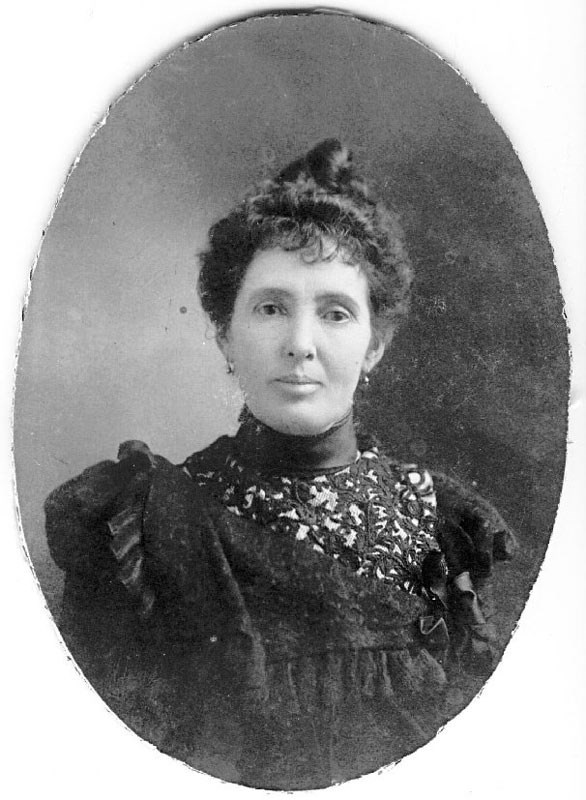
This photo was taken not many years after the death of her husband. She was about 34 years old. As the first lady of Las Vegas, Mrs. Stewart was sought out by distinguished travelers who came through the region. Although not at the center of fashion, she dressed impressively considering how isolated she was.
Questions for Photo 1
1. Describe Helen Stewart's clothing. Is this what you would expect a rancher to wear? Do you think she would have worn clothes like this every day? Why or why not?
2. What image do you think Helen Stewart is trying to convey in this photograph?
3. Why do you think Helen gained the nickname "the first lady of Las Vegas?"
Visual Evidence
Photo 2: Stewart Ranch 1905-06.
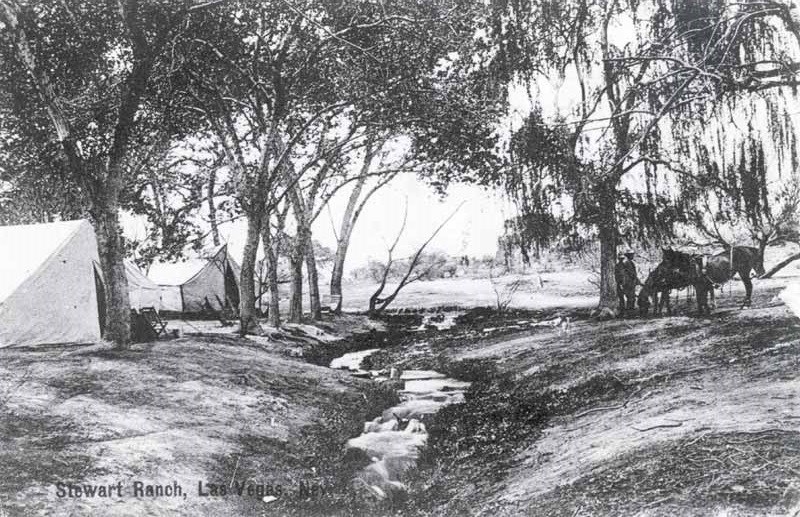
This shows several tents on the Las Vegas Creek occupied in 1905 by people waiting for Clark's townsite to open. Orchards and vineyards were important to the new townspeople. The ranch with its water supply was of great value for the new town rising out of the dry land.
Questions for Photo 2
1. What major event took place in 1905 that might explain the presence of tents on the Stewart Ranch? Who owned the ranch at this time? What purpose did it serve? If needed refer to Reading 2.
2. What personal touches can you see that the residents have added to make their tents feel like "home?"
Visual Evidence
Drawing 1: Ferris Doolittle (1965) sketch of Las Vegas Fort, c. 1912.
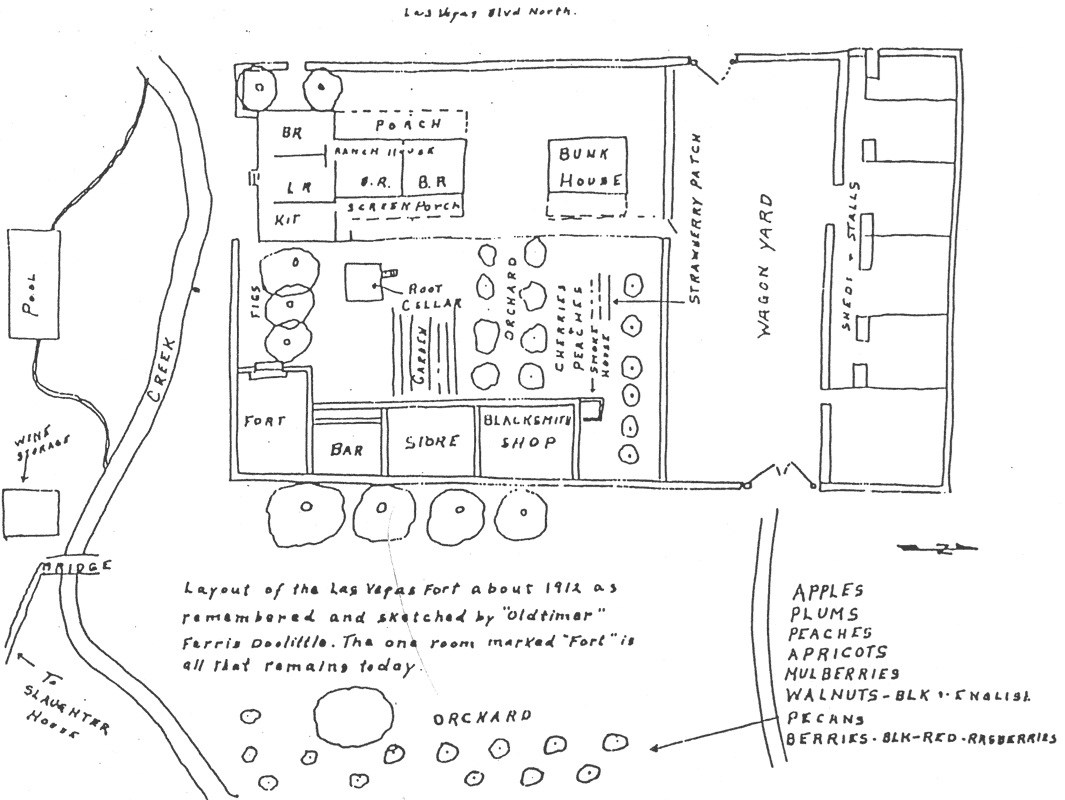
Questions for Drawing 1
1. How did Doolittle know what the fort looked like more than 50 years before he drew this sketch?
2. Examine Drawing 1. What clues do you see to tell you how the fort was used during this time? If needed refer to Readings 2 and 3. How has the fort/ranch changed to serve this purpose?
3. What geographic feature do you see that might make this a good location for the beginnings of a resort town? Why?
Visual Evidence
Photo 3: Theresa Doolittle (swimming pool) at Old Ranch.
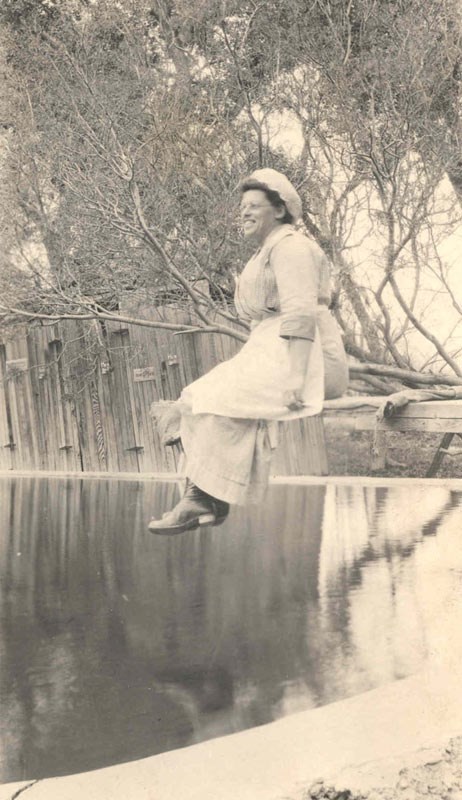
Capitalizing on the water source, an entrepreneur named Harry Beale opened a public resort at the ranch. The ranch became an unofficial park for the town, offering tent cabins for tourists and a primitive swimming pool.
Questions for Photo 3
1. What time period do you think this photo represents? If needed refer to Reading 2 and Drawing 1.
2. Why do you think a pool was such an attraction? How was the pool created? If needed, refer to Reading 2. Where is it in relation to the fort? If needed, refer to Drawing 1.
Visual Evidence
Photo 4: Cement testing site for Hoover dam (curing room added at right), Old Fort c. 1929.
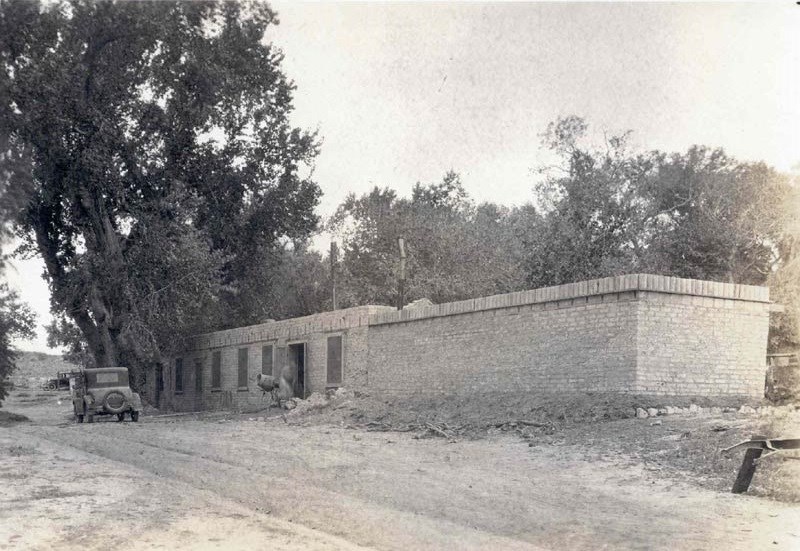
Plans for construction of Hoover Dam opened up a new era for the old fort and ranch. To make the building usable, the Bureau of Reclamation combined three structures into one, made the walls uniform in height, and put in new doorways and windows and a cement floor. It was used for a testing lab for gravel.
Photo 4 of the cement testing site is from the east side of the old fort.
Questions for Photo 4
1. Who owned the building c. 1929? What other activities are happening at the fort/ranch during this period? If needed, refer to Reading 3.
2. Outline the history of the fort and compare and contrast Photo 6 to the other images in Visual Evidence. Do these images give you a better idea as to how the use of the fort has changed over time? Why or why not?
The Old Mormon Fort: Birthplace of Las Vegas, Nevada--
Supplementary Resources
By studying The Old Mormon Fort: Birthplace of Las Vegas, Nevada students will discover the reasons why the Mormons chose Las Vegas as a site for their mission. They will also examine how the historic fort changed over time and gave birth to the city of Las Vegas. Those interested in learning more will find that the Internet offers a variety of interesting materials.
Old Las Vegas Mormon Fort State Historic Park
The park's website contains information on visiting the park as well as detailed descriptions about the fort.
Brigham Young University of Utah Provo
The online special collections at the University library contains a section called Trails of Hope: Overland Diaries and Letters, 1846-1869. This is a collection of the original writings of 49 voyagers on the Mormon, California, Oregon, and Montana trails who wrote while traveling on the trail. Some diarists speak with uncommon eloquence and others with maddening brevity, while telling their stories of persistence and pain, birth and death, God and gold, dust and debris, bugs and buffalo, love and laughter, and trail tedium.
Old Spanish Trail Association
The mission of the Old Spanish Trail Association (OSTA) is to study, preserve, protect, interpret, and promote appropriate use of the Old Spanish National Historic Trail. OSTA promotes public awareness of the Old Spanish National Historic Trail and its multicultural heritage by encouraging research and publication and partnering with governments and private organizations. For more information, please visit the OSTA website.
NPS--Old Spanish National Historic Trail
For more information about the trail of networks that comprised the Old Spanish Trail, please visit the park's website.
The Church of Jesus Christ of Latter-day Saints
For more information about the history of the Church and the pioneers who settled Salt Lake, visit the official website and click on its index.
Nevada History--A Walk in the Past
For more information about the history of Nevada including numerous photographs, maps, histories, and more, please visit this website.
Tags
- nevada history
- nevada
- pioneer
- women's history
- mining
- gold mine
- historic preservation
- archaeological dig
- national register of historic places
- nrhp listing
- teaching with historic places
- twhp
- native american history
- migration and immigration
- womens history
- women and migration
- women leaders
- women in government
- women and the economy
- mid 19th century
- gilded age
- early 20th century
- archaeology
- archeology
- colonial
- early indigenous
- immigration and migration
- farming
- las vegas history
- fort
- twhplp
